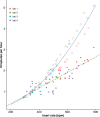Cyclic bouts of extreme bradycardia counteract the high metabolism of frugivorous bats
- PMID: 28923167
- PMCID: PMC5605195
- DOI: 10.7554/eLife.26686
Cyclic bouts of extreme bradycardia counteract the high metabolism of frugivorous bats
Abstract
Active flight requires the ability to efficiently fuel bursts of costly locomotion while maximizing energy conservation during non-flying times. We took a multi-faceted approach to estimate how fruit-eating bats (Uroderma bilobatum) manage a high-energy lifestyle fueled primarily by fig juice. Miniaturized heart rate telemetry shows that they use a novel, cyclic, bradycardic state that reduces daily energetic expenditure by 10% and counteracts heart rates as high as 900 bpm during flight. Uroderma bilobatum support flight with some of the fastest metabolic incorporation rates and dynamic circulating cortisol in vertebrates. These bats will exchange fat reserves within 24 hr, meaning that they must survive on the food of the day and are at daily risk of starvation. Energetic flexibly in U. bilobatum highlights the fundamental role of ecological pressures on integrative energetic networks and the still poorly understood energetic strategies of animals in the tropics.
Keywords: Uroderma bilobatum; ecological physiology; ecology; energetics; flight; heart rate; torpor.
Conflict of interest statement
No competing interests declared.
Figures









References
-
- Aldridge HDJN, Brigham RM. Load carrying and maneuverability in an insectivorous bat: a test of the 5% "rule" of radio-telemetry. Journal of Mammalogy. 1988;69:379–382. doi: 10.2307/1381393. - DOI
-
- Barron DG, Brawn JD, Weatherhead PJ. Meta-analysis of transmitter effects on avian behaviour and ecology. Methods in Ecology and Evolution. 2010;1:180–187. doi: 10.1111/j.2041-210X.2010.00013.x. - DOI
Publication types
MeSH terms
Substances
LinkOut - more resources
Full Text Sources
Other Literature Sources

